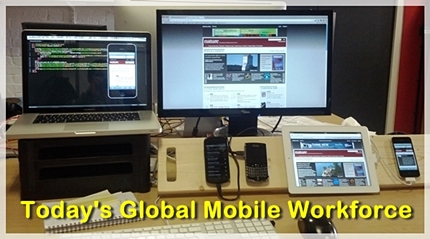Article first published as Overcoming 7 Enterprise Mobility Challenges in Today’s BYOD World on Technorati.
According to the iPass Q1 2012 Global Mobile Workforce Report, the average worker is now carrying around an average of 3.5 mobile devices. Laptops, tablets, smartphones, feature phone and all the hybrids of them. We bring these into our work with us, where we have even more devices. Unless your desk looks like the one above, it becomes a veritable mess of electronics.
Just a few years ago, mobile device management (MDM) was a whole lot easier for user and enterprise alike. Many of us toted around data encrypted BlackBerrys that our employers could remotely lock if we lost it. Back then, both the feature sets of the device, and our expectations of how much work we could get done on it, were lower.
Those days are gone, embedded devices have more processing power and functional capability. And unless you’re in government, finance, or just slow to adopt, you’re using an assortment of different mobile devices. These days, enterprise mobile users need real-time access to multiple corporate applications on a single mobile device to be effective.
7 Enterprise Mobility Challenges
The migration to a more mobile work environment poses significant new challenges for IT organizations. According to enterprise mobility platform provider, Fonemine, today’s large organizations face seven key challenges in trying to empower their workforce with mobile technology.
- Most enterprise applications have no mobile version (yet). So the options are lengthy custom development, or limited use on mobile devices.
- A multitude of point applications that handle complete connected business processes, however lack integration capabilities or connections to the rest of the infrastructure in place in an organization.
- Inconsistent user interfaces make navigating one tool to another a disjointed experience.
- Poor security. An increase in offsite work and a variety of mobile devices can cause problems for corporate IT security pros.
- Vendor-centric apps offer limited or no customization.
- Multiple log-ins. Talk about a productivity killer–it’s a hassle and discouraging to getting things done.
- Not all apps can be used on all mobile platforms. That old BlackBerry we talked about, doesn’t run the apps a new tablet does. And what’s on iOS isn’t necessarily on Android.
There’s a distinct need to get past each of these, as today’s CIOs are focusing on delivering mobile applications that both foster innovation and can revolutionize business processes. This, while also meeting end users’ high performance expectations already established by consumer-grade mobile technologies. By deploying and supporting a multitude of highly functional mobile applications, organizations can transform their workforces into highly efficient mobile teams.
The way to do that is by combining all enterprise systems and content into a single, unified control application. That’s what Fonemine does.
With its MobileForce applications, Fonemine apps seamlessly integrate existing enterprise apps and data, combining them with rich library of interactive widgets and third party plug-ins to provide users a secure, unified interface. The company’s solution provides an array of features designed to address the needs of progressive businesses. Fonemine’s single platform solution allows enterprise sales, marketing, and service, and supporting teams to perform their specific work tasks through today’s popular mobile devices.
MobileForce Compose
Fonemine’s MobileForce Compose enables rapid, cloud-based design, development and deployment of enterprise applications through an online graphical console. Apps can be built fast because it uses a compositional, zero-programming, social media-like drag-n-drop approach so non-programmers can build customized, branded apps quickly and across all the popular smartphone and tablet platforms.
Programmers can take advantage of the approach to start building a basic app fast and seamlessly extend its functionality by simply adding their custom coded components through the platform’s plug-in architecture.
MobileForce for Good
Newly launched at the 2013 Mobile World Congress, Fonemine’s MobileForce for Good, delivers mobile access to all back-end applications and content from any mobile device. Built from the ground up for easy deployment and IT Ready, MobileForce for Good delivers all of its rich functionality from the cloud via SaaS, so there is no need for new CapEx, custom programming or lengthy installations.
Complete with industry standard plug-ins, single sign-on and security standards, it works stand alone or with any MDM or MAM. Privileges, features and system access can also be personalized for users based on their role or function in the organization. It combines the power of native mobile applications – such as offline access and a rich user experience –with all key mobility features such as push notifications, location, camera functionality, and more.
“Our customers have experienced significant productivity gains as a result of MobileForce,” said Jagadish Bandhole, CEO of Fonemine. “For example, when a vice president of sales delivers up-to-the-minute selling information into the hands of reps with just a touch of a button, they are empowering their teams to deliver new levels of customer intimacy. Couple that with instant access to all of their key sales tools and applications in a single user interface on any mobile device, and you’ve got the makings of true 21st century mobile sales warriors.”
And of course, time is money, and Fonemine enables customers to be live in days, instead of the many months required by custom app development.



